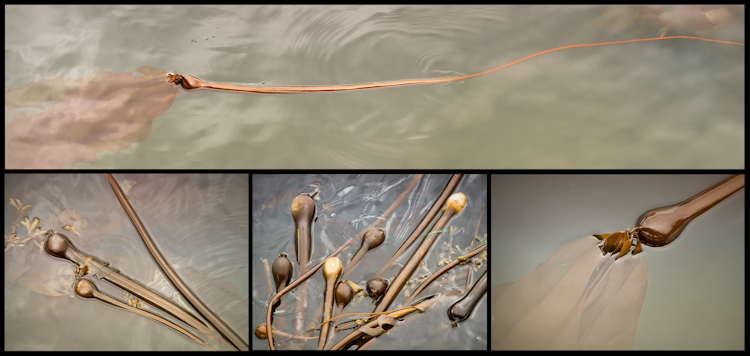click image for larger version
Nereocystis luetkeana
I saw these bull kelp stipes or stems on Elliott Bay in Seattle, rolling with the pulses of the tide and buoyed by their bulbs. The slickness of their whips and ribbons reflect the sun and paint them metallic. It’s a dying sea forest alchemically transformed through the elements of light. The gas-filled bulbs (carbon monoxide) at the tips of 10, 20 and 30-foot strands keep the canopy afloat when the kelp is part of a standing forest. And, when the kelp’s short life ends and its holdfast tears away from its moorings, the kelp (and its float) travels flat on the currents and whims of Puget Sound.
Bull kelp and their kin constitute the forests of the ocean, feeding and shielding marine life and protecting their shores from erosion. Below are a few of the things that bull kelp has, does and is, as it stretches seven or more inches a day until the end of its growing season when it’s whisked away by autumn storms:
- Bull kelp also goes by the name of: bull whip kelp, ribbon kelp, bulb kelp, and sea otter’s cabbage 1
- Bull kelp attaches to bedrock or large cobbles in subtidal zones, clinging by its holdfast, a disc-shaped structure that adheres to substrates
- It’s an annual, growing from early spring to late summer and early fall
- Kelp species provide cover, food and resting areas for a variety of marine life including crustaceans, salmon, rockfish and sea otters
- The calmer waters of kelp beds also provide resting areas for seabirds
- Because kelp is photosynthetic with no root structure, it relies on a large amount of ambient light
- Things that stress kelp: variable or inadequate light; acute changes in salinity, temperature or oxygen; toxics like oil; sedimentation, which can prevent spores or zygotes from attaching; illegal harvest2
- Things that help kelp: Nearshore habitat improvements like dam removal, reduced boat disturbances, control of invasive species and reduced overwater structures (for light penetration) 2
1 Department of Ecology Shorelines Project
2 Kelp and Eelgrass in Puget Sound (pdf)


Ingrid, I didn’t know that this kelp was an annual so I have learned something new today. I remember large matts of floating kelp when I cruised along the Inner Passage. I stood on deck and watched them for a long time while observing sea birds resting on them.
Mia, I didn’t either until I did more extensive reading on it. I guess I didn’t know how it was classified, actually. I admit, I’m enamored with bull kelp — its massiveness, textures, colors. I found huge piles on a Sonoma beach once and just sat for hours, photographing it.
Interesting post Ingrid – the biologist in me loves this kind of info and I really enjoyed your collage images.
Thanks, Ron. I envy the biologist’s perspective, experience and expertise. I was heading toward a career in vet medicine until college-level science courses took me down, and I realized I was a better match for the liberal arts. My admittedly unscientific view is thus far too subjective, eclectic and unpredictable. I learn as I go along … I mean, stumble along.